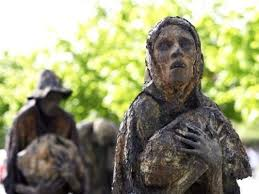19 April 1741: In a letter to Dr. Thomas Prior, Dublin, the Bishop of Cloyne, Dr. George Berkeley, wrote of the Famine which was then raging:
The distresses of the sick and poor are endless. The havoc of mankind in the counties of Cork, Limerick and some adjacent places hath been incredible. The nation, probably, will not recover this loss in a century. The other day I heard one from the county of Limerick say that whole villages were entirely dispeopled.
The Great Famine of 1741 had its origins in the ‘Great Frost’ of January 1740 when an intense and bitter cold that emanated from the Arctic and not been experienced in living memory swept across Western Europe. So cold was it that birds dropped from the sky and seed was destroyed in the ground. Trade came to a halt as ports froze up and travel became almost impossible. In the Springtime the expected rains did not come, and though the Frost dissipated, the temperatures remained low and the northerly winds very strong. By the Summer of 1740, the Frost had decimated the potatoes and drought had wrought havoc with the grain harvest and the herds of cattle and sheep had suffered huge losses.
In the Autumn a meagre harvest commenced and prices in the towns started to fall. Cattle began to recover, but in the dairying districts, cows had been so weak after the Frost that at least a third of them had failed to “take bull”. Then blizzards swept along the east coast in late October and more snow fell several times in November. A massive downpour of rain fell on 9 December causing widespread flooding. A day after the floods, the temperature plummeted, snow fell, and rivers and other bodies of water froze. Warm temperatures followed the cold snap, which lasted about ten days. Great chunks of ice careened down the River Liffey and through the heart of Dublin, overturning light vessels and causing larger vessels to break anchor. The price of foodstuffs rocketed and people began to starve.
The Spring of 1741 went down in popular memory as the Black Spring of ’41 as the impact of two very hard Winters and the destruction of so much livestock and grain supplies began to be felt. This was especially so amongst the rural and urban poor of whom there were very many in Ireland at that time. Diseases swept the Country: Dysentery; Smallpox and Typhus took the lives of many thousands.
Sir Richard Cox wrote from Cork in April that year:
Mortality is now no longer heeded; the instances are so frequent. And burying the dead, which used to be one of the most religious acts among the Irish, is now become a burthen…In short, by all I can learn, the dreadfullest civil war, or most raging plague never destroyed so many as this season. The distempers and famine increase so that it is no vain fear that there will not be hands to save the harvest.
Eventually in the Summer of 1741 the Crises abated and while the situation was still very hard the plagues and starvation eased off. The next Harvest while not abundant was sufficient to ensure that enough food would be available to avert a similar situation the following year.
So ended what was the worst set of recorded climate related disasters to hit Ireland since at least the early 14th Century. Nobody knows how many people died as a result of this Great Famine of 1741 and the hardships that preceded its apogee. Out of an overall estimated population at the time of around three million souls it seems probable that between 300,000 to 450,000 died as a result of disease & starvation – a mortality rate that stands comparison with if it did not actually exceed the more infamous events of the 1840s.
Pictures: http://antarcticspring.deviantart.com/art/Vanitas-famine-284255931 & the Famine Memorial Dublin


No comments:
Post a Comment